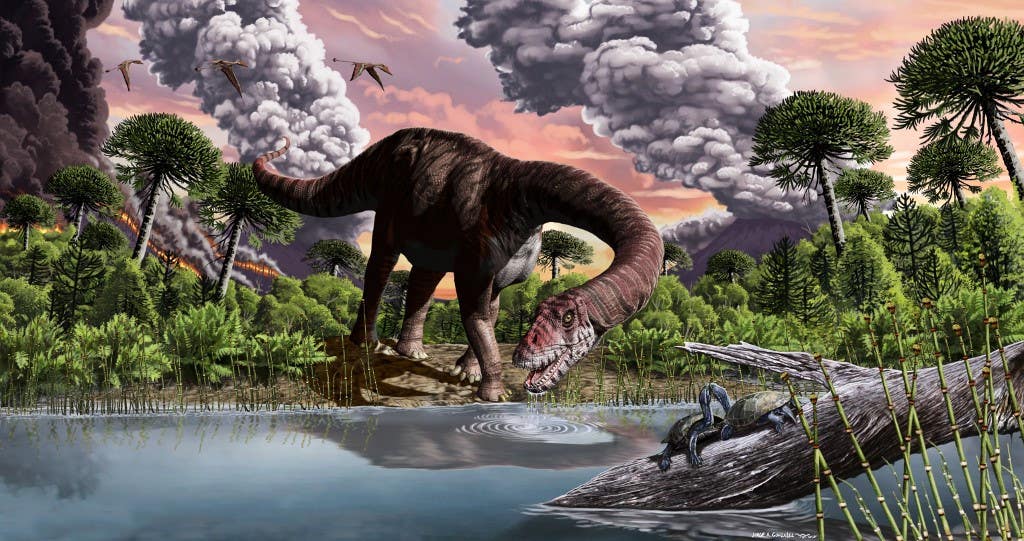Major discovery identifies the surprising reason dinosaurs rose to prominence
Climate change, rather than competition, played a key role in the rise of dinosaurs through the Late Triassic and Early Jurassic periods.

[Dec 19, 2022: Beck Lockwood, University of Birmingham]
Climate change, rather than competition, played a key role in the ascendancy of dinosaurs through the Late Triassic and Early Jurassic periods. (CREDIT: Creative Commons)
Climate change, rather than competition, played a key role in the ascendancy of dinosaurs through the Late Triassic and Early Jurassic periods.
According to new research, changes in global climate associated with the Triassic-Jurassic mass extinction – which wiped out many large terrestrial vertebrates such as the giant armadillo-like aetosaurs – actually benefitted the earliest dinosaurs.
The ascendancy of dinosaurs to become dominant components of terrestrial ecosystems was a pivotal event in the history of life, yet the drivers of their early evolution and biodiversity are poorly understood.
During their early diversification in the Late Triassic, dinosaurs were initially rare and geographically restricted, only attaining wider distributions and greater abundance following the end-Triassic mass extinction event.
Related Stories
This pattern is consistent with an opportunistic expansion model, initiated by the extinction of co-occurring groups such as aetosaurs, rauisuchians, and therapsids. However, this pattern could instead be a response to changes in global climatic distributions through the Triassic to Jurassic transition, especially given the increasing evidence that climate played a key role in constraining Triassic dinosaur distributions.
In particular, sauropod-like dinosaurs, which became the giant herbivore species of the later Jurassic like Diplodocus and Brachiosaurus, were able to thrive and expand across new territories as the planet warmed up after the extinction event, 201 million years ago.
The new evidence is published in Current Biology, by an international team of palaeontologists led by the Universities of Birmingham and Bristol, in the UK, Friedrich-Alexander University Erlangen-Nürnberg (FAU), in Germany, and the University of São Paulo in Brazil.
The team compared computer models of prehistoric global climate conditions such as temperature and rainfall with data on the different locations of dinosaurs taken from sources such as the Paleobiology Database. They showed how the sauropods, and sauropod-like animals, with their long tails and necks and small heads, were the runaway success story of a turbulent period of evolution.
Statistical analyses show that Late Triassic sauropodomorph dinosaurs occupied a more restricted climatic niche space than other tetrapods and dinosaurs, being excluded from the hottest, low-latitude climate zones. A subsequent, earliest Jurassic expansion of sauropodomorph geographic distribution is linked to the expansion of their preferred climatic conditions.
Evolutionary model-fitting analyses provide evidence for an important evolutionary shift from cooler to warmer climatic niches during the origin of Sauropoda. These results are consistent with the hypothesis that global abundance of sauropodomorph dinosaurs was facilitated by climatic change and provide support for the key role of climate in the ascendancy of dinosaurs.
Dr Emma Dunne, now a lecturer in palaeontology at FAU, carried out the research while at the University of Birmingham. She said: “What we see in the data suggests that instead of dinosaurs being outcompeted by other large vertebrates, it was variations in climate conditions that were restricting their diversity. But once these conditions changed across the Triassic-Jurassic boundary, they were able to flourish."
Paleobiology Database
“The results were somewhat surprising, because it turns out that sauropods were really fussy from the get-go: later in their evolution they continue to stay in warmer areas and avoid polar regions.”
Co-author on the paper, Professor Richard Butler, at the University of Birmingham, said: “Climate change appears to have been really important in driving the evolution of early dinosaurs. What we want to do next is use the same techniques to understand the role of climate in the next 120 million years of the dinosaur story”.
When did dinosaurs live?
Non-bird dinosaurs lived between about 245 and 66 million years ago, in a time known as the Mesozoic Era. This was many millions of years before the first modern humans, Homo sapiens, appeared.
Graphical abstract of dinosaur migration. (CREDIT: Current Biology)
Scientists divide the Mesozoic Era into three periods: the Triassic, Jurassic and Cretaceous. During this era, the land gradually split from one huge continent into smaller ones. The associated changes in the climate and vegetation affected how dinosaurs evolved.
Triassic Period (252 to 201 million years ago)
All continents during the Triassic Period were part of a single land mass called Pangaea. This meant that differences between animals or plants found in different areas were minor.
The climate was relatively hot and dry, and much of the land was covered with large deserts. Unlike today, there were no polar ice caps.
It was in this environment that the reptiles known as dinosaurs first evolved. Reptiles tend to flourish in hot climates because their skin is less porous than, for example, mammal skin, so it loses less water in the heat. Reptile kidneys are also better at conserving water.
Toward the end of the Triassic, a series of earthquakes and massive volcanic eruptions caused Pangaea to slowly begin to break into two. This was the birth of the North Atlantic Ocean.
Jurassic Period (201 to 145 million years ago)
At the end of the Triassic Period there was a mass extinction, the causes of which are still hotly debated. Many large land animals were wiped out but the dinosaurs survived, giving them the opportunity to evolve into a wide variety of forms and increase in number.
The single land mass, Pangaea, split into two, creating Laurasia in the north and Gondwana in the south. Despite this separation, similarities in their fossil records show that there were some land connections between the two continents early in the Jurassic. These regions became more distinct later in the period.
Temperatures fell slightly, although it was still warmer than today due to higher amounts of carbon dioxide in the atmosphere. Rainfall increased as a result of the large seas appearing between the land masses.
These changes allowed plants such as ferns and horsetails to grow over huge areas. Some of this vegetation became the fossil fuels that we mine today. Elsewhere there were forests of tall conifer trees such as sequoias and monkey puzzles.
The plentiful plant supply allowed the huge plant-eating sauropods - such as Apatosaurus, Diplodocus and Brachiosaurus - to evolve. These are some of the largest animals to have ever walked the Earth. By the end of the Jurassic their herds dominated the landscape. Sauropods became even larger in the Cretaceous.
Cretaceous Period (145 to 66 million years ago)
During the Cretaceous the land separated further into some of the continents we recognise today, although in different positions. This meant that dinosaurs evolved independently in different parts of the world, becoming more diverse.
Other groups of organisms also diversified. The first snakes evolved during this time, as well as the first flowering plants. Various insect groups appeared, including bees, which helped increase the spread of flowering plants. And mammals now included tree climbers, ground dwellers and even predators of small dinosaurs.
For more science stories check out our New Discoveries section at The Brighter Side of News.
Note: Materials provided above by University of Birmingham. Content may be edited for style and length.
Like these kind of feel good stories? Get the Brighter Side of News' newsletter.
Joseph Shavit
Head Science News Writer | Communicating Innovation & Discovery
Based in Los Angeles, Joseph Shavit is an accomplished science journalist, head science news writer and co-founder at The Brighter Side of News, where he translates cutting-edge discoveries into compelling stories for a broad audience. With a strong background spanning science, business, product management, media leadership, and entrepreneurship, Joseph brings a unique perspective to science communication. His expertise allows him to uncover the intersection of technological advancements and market potential, shedding light on how groundbreaking research evolves into transformative products and industries.



